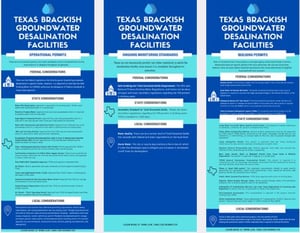Students in Texas A&M Law's environmental law program, officially named the Energy, Environmental, and Natural Resource Systems Law Program (EENRSLP) created a toolbox for entities building water desalination and water recycling facilities. Desalination is the process of turning brackish or salty water into drinking water, while water recycling extracts water from the waste stream, treats it, and makes it usable for certain productive uses. Given the scarcity of water, in Texas particularly, both processes are highly sought after solutions.
Authors Seth J. Boettcher, Courtney Gately, Alexandra L. Lizano, Alexis S. Long and Alexis Yelvington participated in the EENRSLP Spring 2020 Capstone. Their reports are designed to help regulators, utilities, and the private sector navigate the legal and regulatory framework, and they identify required federal and local permits and other compliance criteria.
All three technical reports compile information based on extensive research into available literature and documents from various local, state, and federal agencies. While there is no “one-stop-shop” resource that provides detailed information on all the necessary permits to build, operate, and maintain such facilities, these guides aim to compile the existing, available information in an organized and accessible fashion.
For more information and helpful visual aids, click here.

Pictured above: Seth J. Boettcher ‘20, Courtney Gately ‘21, Alexandra L. Lizano ‘20, Alexis Long ‘20, and Alexis Yelvington ‘20
Acknowledging the centrality and complexity of natural resources systems, the Energy, Environmental, and Natural Resource Systems Law Program (EENRSLP) at Texas A&M School of Law endeavors to train and offer real world experience to students on law and policy issues related to exploitation, management and conservation, and advance research on natural resources that connects with other disciplines and with communities worldwide.To learn more about the Energy, Environmental, and Natural Resource Systems Law Program at Texas A&M Law, click here.
